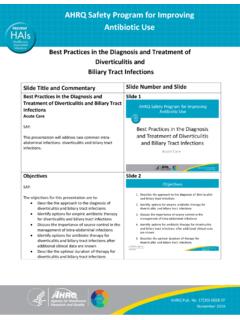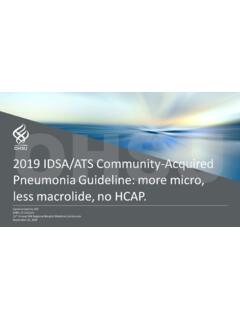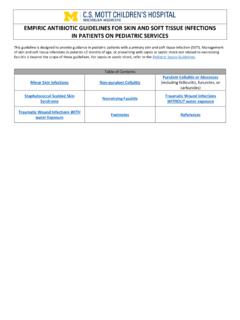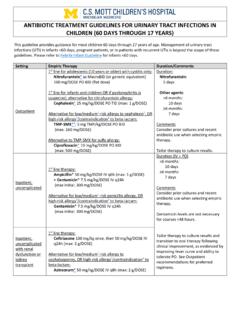Transcription of Antibiotic Stewardship Metrics: How do you measure up?
1 Antibiotic Stewardship metrics : how do you measure up?Kristi Kuper, PharmD, BCPSSr. Clinical Manager, and Disclosures1. Define metrics that can be used to measure Antibiotic utilization2. Define metrics that can be used to measure an Antibiotic Stewardship program s performance 3. Describe the strengths and weaknesses of these metricsI have no disclosures2 What do the CDC Core Elements Say About Measuring Antibiotic Use?CategoryStatementAcute careMeasurement is critical to identify opportunities for improvement and assess the impact of improvement efforts (87). For Antibiotic Stewardship , measurement may involve evaluation of both process (Are policies and guidelines being followed as expected?) and outcome (Have interventions improved Antibiotic use and patient outcomes?).Long term careProvide regular feedback on Antibiotic use andresistance to prescribing clinicians, nursing staffand other relevant staffCritical access hospitalsDays of therapy is considered the most useful measure of Antibiotic use to inform stewardshipefforts.
2 Facilities can electronically capture, analyze and benchmark days of therapy throughthe CDC s adherence to treatment recommendations and performance of interventions suchas Antibiotic time-outs can be useful to further guide quality improvement efforts. In addition,small and critical access hospitals are well positioned to monitor Antibiotic use at the prescribing practices and offer regular feedback to clinicians, or have clinicians assess their own Antibiotic prescribing practices : CDC Core Elements of Antibiotic Stewardship , Barlam TF, Cosgrove SE, Abbo LM, et al., Clin Infect Dis. 2016;62:e51-e77 What Do Other Organizations Say About Measuring Antibiotic Use?OrganizationStatementIDSA/SHEA(2016) We recommend measuring Antibiotic costs based on prescriptionsor administrations instead of purchasing data(good practice recommendation).Joint Commission The organization collects and analyzes data on its antimicrobial Stewardship program, including antimicrobial prescribing and resistance patternsDNVNo info availableLeapFrogDoes your facility monitor Antibiotic use (consumption) at the unit,service, and/or facility wide?
3 US News and WorldReport [Children s Hospital Ranking]At least FTE support for a dedicated analyst to support ASP program4 Antibiotic metrics 1015 Measuring Antibiotic useAccurate reflection of actual Antibiotic utilization Ease to ObtainFinancial MetricsDefined dailydose per 1,000patient daysDays of therapy per 1,000 patientdaysDays of therapy per 1,000 days present(AU CDC)6 Financial metrics Antibiotic cost per patient day (inpatient only) Antibiotic cost per adjusted patient day (inpatient + outpatient) Antibiotic cost (%) to total drug budget Total spend Wastage -% wastage for specific drugs Antibiotic cost per discharge CMI adjusted __fill in the blank __ Cost per MS DRG (ID related) Cost per length of stay Cost due to readmissions7 Financial MetricsCOST = UTILIZATION X PRICECost influencers Inventory builds or burns DSH (inpatient) 340B (outpatient) Generic launches Drug shortagesYearPrice per doseTotal Spend2011$335$335,0002012$300$300,000201 3$200$200,0002014$125$125,0002015$ 75 $ 75,000 Annual Purchases: 1000 doses8 Defined Daily Dose 9 Standardized definition of daily Antibiotic doseCreated by the World Health OrganizationCorrection factor: Total Units ( mg) DrugDDD Correction FactorPros:Attempts to convert raw purchasing data into utilization dataAllows comparisons with other institutionsEasy to calculateCons.
4 Not everyone agrees with the DDDs International vs USMany use institution-specific correction factors (prescribed daily dose)Not patient level informationWHO Website10 Calculating the DDDL evofloxacin Dose varies in US 250mg, 500mg, or 750mg daily Available in IV or PO Let s say you get a report of levofloxacin 750mg use for the month of January and you have given 300 doses of levofloxacin 750mg IV and 150doses of 500mg PO What is the total DDD?11 Oral ; P= ParenteralCalculating Levofloxacin DDD 12 DoseRouteTotal DispensedTotal amount (mg)Total amount (grams)WHO expressed per 1000 patient daysLevo-floxacinRouteDDDT otal patient daysDDD/1000 ptdays500mgPO1507,50020750mg IV4507,50060= (DDD/ptdays) x 1000 Lessons learned from calculating DDDs It s not perfect It s not always straightforward Combination products are tricky Piperacillin /tazobactam = only count piperacillin (14g) Drugs dosed in other units besides grams can be a challenge If low use, consider counting doses vs units Using alternate correction factors matters less if you are comparing yourself to yourself If all you have is purchase data, you can still calculate it use units purchased13 Days of Therapy14 Aggregate sum of days for which any amount of specific antimicrobial agent was administered to individual patientsObtained from electronic medication administration record (eMAR)
5 Or bar code medication administration (BCMA) dataDays of Therapy per 1,000 patient days Total days of vancomycin 1 gm every 12 hours = 20 Total days of vancomcyin1gm every 24 hours = 30 Total days of vancomycin 750mg every 24 hours = 10 Total days of vancomcyintherapy this month = 60 Total patient days = 500 DOT = Vancomycin days /patient days x 1000 DOT = 60/500 x 1000 DOT = 120 DOT/1000 patient days 15 DDD vs DOT 16 Pros:Standard comparisons using aggregate utilization dataWill change estimate of drug use if high doses are use, but standard is not changedCons:Not a surrogate for DOT when dose is different than standard: Cannot be used for: children, renal dysfunctionDDD can change with timePros:Can be used in childrenNot influenced by changes in the DDD standardsNot subject to differences in institutional preferencePatient-specific informationCons:Overestimates use for drugs given multiple times per dayMore difficult to measure without computerized recordsDDDDOTS lide courtesy of Libby DoddsAshley, PharmD, MHS, FCCP, BCPS -DASONPolk RE.
6 Clin Infect Dis2007; 44 vs. DOTPolk RE. Clin Infect Dis2007; 44 courtesy of Libby DoddsAshley, PharmD, MHS, FCCP, BCPS -DASON17 Other Common DenominatorsAdmissionsCDC Definition: The aggregate number of patients admitted to the facility starting on the first day of each month through the end of the calendar monthDischargesExcludes patients who expire in the hospitalAlso should exclude healthy newbornsCase Mix Index AdjustedCommonly used in hospital systems to account for variations in location acuity18 Other Utilization MetricsDOT/1000 patient days present (AU)IV to PO Percentage or Percentage PO LOT/1000 ptdaysNumber of patients on antibiotics Day Per Visit19 DOT = Days of TherapyLOT = Length of TherapyLong Term Care 20 Slide credit: Sarah Kabbani, MD, CDC, SHEA 2018 Long Term Care21 Slide credit: Sarah Kabbani, MD, CDC, SHEA 2018 Great Reference 22 Other Metrics23 Advanced Utilization Process Prescriber Outcome Quality/SafetyAdvanced Utilization metrics % admissions that received certain antibiotics Point prevalence study looking at what is happening house wide at a pre-selected time DOT by provider Average LOT for specific antibiotics % of therapy appropriate indication or ICD9/10 codes % of time empiric therapy was appropriate for a certain indication Choice/Change/Completion looking at empiric , narrow, complete therapy DOT/LOT24 DOT by Service LineMS DRG GroupingsClin Infect Dis.
7 2011 Dec;53(11):1100-1025 Process Measures Interventions Renal dosing IV to PO De escalation Therapy Cessation Percent ordered per protocol/guidelines Culture collected before antimicrobial being administered Intervention acceptance rate Average number of interventions per patient reviewed Redundant therapy events % orders with start and stop date MSSA and receiving a beta lactam Compliance to best practice bundlesCID 2017:64 (1 February)26 Prescriber metrics Drug utilization by prescriber Debate about whether to blind info or use name Challenge when you can only get attending physician s name. When at academic medical center, consider by service Percent of orders for antimicrobials that required action Acceptance rates ID physician consult rates27 Outcomes MetricsResistance ratesTheoretical, difficult to measure short termClostridium difficile ratesBalancing measure pts that were de-escalated that were then escalated28 Quality/Safety Measures Percent of time diseases specific order set was used Adverse drug events reported Time to appropriate therapy Time to therapeutic concentrations Adverse drug event rates Time to appropriate Antibiotic trough levels (vancomycin) Time to PO conversion CLABSI rates Mortality PICC line complications29 Sample DashboardCreate a dashboard and report at a designated frequency30 Using Your metrics to Drive ChangeWho?
8 What ?When ?Where ?Why?31 References N, et al. Understanding inpatient antimicrobial Stewardship metrics . Am J Health Systems Pharmacists 2018;75 information is proprietary and highly confidential. Any unauthorized dissemination, distribution or copying is strictly prohibited. Any violation of this prohibition may be subject to penalties and recourse under the law. Copyright 2016 Vizient, Inc. All rights Kuper, PharmD, BCPS Antibiotic Utilization and Resistance (AUR)ModuleModule designed to capture Antibiotic use data through electronic input through NHSNAU measures Antibiotic days per 1000 days presentAR measures resistance and resistance trendsStandardized Antibiotic Administration Ratio (SAAR) Antibiotic Use Tracking35AU Outputs36 CDC s 1st attempt at developing a quality improvement measure for Antibiotic in principle to the Standardized Infection Ration (SIR).SAAR expresses observed Antibiotic use compared to predicted worked with many partners to develop the SAAR measure to try and make it most useful for Antibiotic Administration Ratio (SAAR)37 AdultMedical and Surgical ICUsMedical and Surgical wardsAll medical and surgical locations combinedPediatricMedical and Surgical ICUsMedical and Surgical wardsAll medical and surgical locations combinedStandardized Antibiotic Administration Ratio (SAAR):Patient Location Groupings38 Standardized Antibiotic Administration Ratio (SAAR).
9 Antibiotic Groupings Broad spectrum agents for hospital-onset/multi-drug resistant infections Amikacin, aztreonam, cefepime, ceftazidime, ceftazidime/avibactam, ceftolozane/tazobactam, colistimethate, doripenem, gentamicin, imipenem/cilastatin, meropenem, piperacillin, piperacillin/tazobactam, polymixin B, ticarcillin/clavulanate, tigecycline, tobramycin Broad spectrum agents predominantly used for community-acquired infections Cefotaxime, ceftriaxone, ciprofloxacin, ertapenem, gemifloxacin, levofloxacin, moxifloxacin Anti-MRSA agents Ceftaroline, dalbavancin, daptomycin, linezolid, oritavancin, quinupristin/dalfopristin, tedizolid, telavancin, vancomycin Agents for surgical site infection prophylaxis Cefazolin, cefotetan, cefoxitin, cefuroxime, cephalexin All agentsSlide courtesy of Libby DoddsAshley, PharmD, MHS, FCCP, BCPS -DASON39 SAAR Report Output40 Data for Example Only. Slide source: CDCSAAR Report Output41 Data for Example Only.
10 Slide source: CDC









